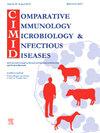动物节中人类与蛇的文化互动是监测人畜共患细菌病原体的一个机会
IF 2
3区 农林科学
Q4 IMMUNOLOGY
Comparative Immunology Microbiology and Infectious Diseases
Pub Date : 2025-02-12
DOI:10.1016/j.cimid.2025.102325
引用次数: 0
摘要
爬行动物携带多种病原体,其中一些可能对人类健康构成威胁。其中,蛇是监测病原体的宝贵哨兵,特别是在某些文化背景下,动物与人类的互动提供了一个独特的机会,可以多年来深入研究细菌动态。在意大利中部以圣多梅尼科蛇节而闻名的科库洛,一年一度的蛇仪式“festa dei serpari”就是这样。本研究对2010年至2023年(不包括2020年和2021年)在仪式期间捕获的野生蛇相关细菌病原体的综合数据库进行了回顾性分析。使用不同的采样方法,包括肛肠、口腔和皮肤拭子以及粪便材料,从465条为这一独特仪式采集的登记蛇中收集了563个生物样本。对样本进行了分析,以评估蛇身上细菌种类的流行程度以及对人类健康的潜在风险。在两个国家参考研究所使用传统培养基、分子诊断、生化分析和质谱法鉴定了70种细菌。其中,沙门氏菌、大肠杆菌、耐药铜绿假单胞菌和肺炎克雷伯菌等人畜共患和机会性细菌尤其值得关注。结果还揭示了调查期间的重要趋势,革兰氏阴性菌和严重葡萄球菌的流行率上升,沙门氏菌的流行率下降。我们的研究结果强调了持续监测人畜共患病原体的重要性,因为在这一神圣亵渎的历史仪式中,人蛇之间发生了密切的相互作用。本文章由计算机程序翻译,如有差异,请以英文原文为准。
Cultural human-snake interactions in the festa dei serpari as an opportunity for the surveillance of bacterial pathogens of zoonotic concern
Reptiles harbour a wide range of pathogen species, some of which can pose risks to human health. Among them, snakes serve as valuable sentinels for monitoring pathogens, particularly in some cultural contexts where animal-human interactions offer a unique opportunity to delve into bacterial dynamics throughout the years. This is the case of the annual serpent ritual “festa dei serpari” in Cocullo, in central Italy renowned for the San Domenico snakes festival. This study conducted a retrospective analysis of a comprehensive database of bacterial pathogens associated with wild snakes captured during the ritual, from 2010 to 2023 (excluding 2020 and 2021). Using different sampling methods, comprising cloacal, oral, and cutaneous swabs, along with faecal material, a total of 563 biological samples were collected from 465 registered snakes harvested for this unique ritual. Samples were analysed to assess the prevalence of bacterial species on snakes and the potential risks to human health. Seventy bacterial species were identified using traditional growth media, molecular diagnosis, biochemical analyses, and mass spectrometry performed in two national reference institutes. Among the results, zoonotic and opportunistic bacteria such as Salmonella spp., Escherichia coli, and drug-resistant Pseudomonas aeruginosa and Klebsiella pneumoniae were of particular concern. The results also revealed significant trends during the years under investigation, with an increasing prevalence of Gram-negative bacteria and Staphylococcus sciuri, along with a decline in Salmonella spp. Our findings emphasize the importance of continued surveillance of zoonotic pathogens, given the close human-snake interactions that occur during this Sacro-profane historical ritual.
求助全文
通过发布文献求助,成功后即可免费获取论文全文。
去求助
来源期刊
CiteScore
4.60
自引率
0.00%
发文量
102
审稿时长
40 days
期刊介绍:
Comparative Immunology, Microbiology & Infectious Diseases aims to respond to the concept of "One Medicine" and to provide a venue for scientific exchange. Based on the concept of "Comparative Medicine" interdisciplinary cooperation between specialists in human and animal medicine is of mutual interest and benefit. Therefore, there is need to combine the respective interest of physicians, veterinarians and other health professionals for comparative studies relevant to either human or animal medicine .
The journal is open to subjects of common interest related to the immunology, immunopathology, microbiology, parasitology and epidemiology of human and animal infectious diseases, especially zoonotic infections, and animal models of human infectious diseases. The role of environmental factors in disease emergence is emphasized. CIMID is mainly focusing on applied veterinary and human medicine rather than on fundamental experimental research.

 求助内容:
求助内容: 应助结果提醒方式:
应助结果提醒方式:


